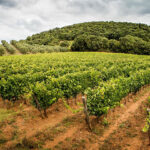The Sweet Spot for Direct Wine Sales. For US wineries, finding the happy medium between direct-to-consumer sales and the three-tier system is paramount / Il punto debole per la vendita diretta di vino. Per le aziende vinicole statunitensi, trovare il giusto mezzo tra le vendite dirette al consumatore e il sistema a tre livelli è fondamentale.
by Liza B. Zimmerman
The Sweet Spot for Direct Wine Sales. Traveling around hidden corners of the wine world makes you wonder why certain regions, and their wineries, aren’t more invested in nationally distributing their brands.
There are huge swaths of the country – particularly in less-visited places like Idaho, Western Washington and Southern Oregon – where few brands get to the next big city: much less an hour down the road.
A primary focus on the director-to-consumer (DtC) sales channel is clearly both a lifesaver, in terms of margins; and a limitation, in terms of overall profits; as to how much wine can be sold by wineries. If a winery is limited to only the DtC channel, by total-production size or preference, they may well be barely known outside of their home turf or able to build a national brand.
According to Larry Cormier, the vice president and general manager of the Boulder, Colorado-based SOVOS ShipCompliant, which tracks DtC shipments, “our years of tracking data … show that wineries of all sizes participate in the [DtC] channel and that historically and currently, small wineries [defined as those producing 5000 to 49,999 cases annually] have really depended on …[it] for their success. Per our 2022 report, the small-winery size category accounts for 43.3 percent of all wine shipped DtC in the United States.”
Clearly margins – per bottle – have always been higher on brands that are sold DtC. However, no winery can compete for overall volume of sales that can be achieved with the power of a strong distributor behind them. The smartest US wineries seem to use one sales approach to support another: providing consumers with a unique experience at the winery that may drive them to buy the wines at later occasions on- and off-premise: and vice versa.
Balance: no easy thing
Some of the country’s most successful wineries know how to maximize the benefits of each sales platform. Carol Reber, the executive vice president, chief marketing and DtC officer of the St. Helena, California-based Duckhorn, a winery that has long exceled with both DtC and wholesale, notes: “DtC is an important avenue in which we look to create meaningful connections with our consumers and share our love of fine wine and all things ‘Wine Country’.”
She stresses that she does not favor one sales method over another. “When we do our jobs well in DtC, our guests become evangelists and seek our wines out, wherever they may be.”
For Reber, the future of DtC is to have a 365-degree view of the consumer. She adds that showing that the winery knows when customers “visited, what we poured them that they enjoyed most, when they called, and/or what their online habits, we can meet so many more of our members’ wine needs”. In doing so, DtC can help to drive three-tier sales.
“There is no perfect balance between three-tier and DtC,” agrees Tom Wark, the executive director of the National Association of Wine Retailers (NAWR). “Everything depends on the aspirations of the producer… Doing this is much easier if you are making 15,000 cases or more. At 5000 cases produced annually, it is difficult to serve various three-tier markets.”
Which sales approach is most advantageous also depends on how producers want to go after the market and build their brands. “Some producers like and want to conquer the national market. It’s a challenge. Others want to look their customers in the eye, focus on making less wine and generate revenue via higher margins,” Wark shares.
“Neither [sales channel] is inherently better,” affirms Cormier of Sovos. “Many producers distribute products through each channel, creating a reason and opportunity for loyal customers to purchase [both] via DtC and three-tier.”
Investment banker Erik McLaughlin, the CEO of Metis, a Washington-based mergers and acquisition firm, confirms that strong DtC sales “build strong brand loyalty and help distribution”. What is more, he adds: “Some of the most successful wine brands excel in both channels and find them mutually complimentary.”
Unique benefits of DtC
Wineries that excel at cellar-to-consumer sales – whether they are nationally distributed or not – tend to offer guests a unique and sought-out experience when they visit the vineyards. “In order to create value for the consumer you need to create something that the consumer can’t get through retail,” shares Bourcard Nesin, a beverage analyst at New York’s Rabobank, echoing Reber’s words.
The two types of wineries that tend to excel at it, he continues, are generally small producers and super, high-end brands: or potentially some combination of the two. As a result, there is a strong correlation between size and which producers primarily DtC: with smaller producers preferring that sales method. He adds that Duckhorn in Napa and Daou Vineyards in Paso Robles – which declined to comment for this story – both walk that tightrope in a magical way.
For a winery playing in both sales channels, a great way to differentiate themselves would be by offering guests access to new releases, unique food and wine pairings and private tasting areas. For established wineries like Jordan, in Sonoma, DtC sales also happen in a number of channels from during winery visits to online sales. The winery, according to Maribel Soto, director of estate services and DtC, does about 10 percent of its business Dtc. Not surprisingly, the two channels operate separately at Jordan.
However, the financial advantages of selling DtC are apparent. “A winery that sells a wine at $50 a bottle via DtC must sell it to a distributor for $25 a bottle. That’s a huge discount. Moreover, you don’t get the names of the folks who bought the wine,” shares Wark.
The costs of DtC
Moving all of a winery’s product through a DtC platform can obviously limit its overall profits and prevent it from truly becoming a national brand. If a winery’s profitability “is predicated on people moving through your tasting room, you can’t create enough scale to compete with the profitability of a nationally distributed brand”, shares Nesin. This remains the larger – and more important equation on how to make big money, long-term in the wine business.
So, the bigger you get, he notes, “the less profitable your next customer is to acquire”. This is because, he adds, that many DtC brands – as is true in the food and the competitive at-home, food-kit preparation world as well – will then have to look for their next customers on social media outlets. This might be Facebook, Instagram or working with institutions like American Express to promote your brand through its cards.
To put it in different terms, “sales to distributors generally net about 45 percent of the retail value and wines sold DtC net around 85 to 90 percent of retail value”, shares McLaughlin. “That said, wines sold through distribution tend to be a lower average retail price per bottle than DtC, which sells a higher percentage of more expensive offerings.”
As a result, smaller to mid-sized wineries will be increasingly forced to further develop and expand their DtC sales programs because of their potential difficulties in accessing the marketplace via the three-tier wholesale channel.
Smaller wineries can, and should, rely more heavily on selling their wines through the DtC channel, advises Mario Zepponi, a wine merger and acquisition advisor at the Santa Rosa-based Zepponi & Company. “A healthy DtC program will account for a minimum of 30 percent of a winery’s overall sales,” he concludes. This can be true even if a winery has a strong three-tier sales business.
The investment consultant McLaughlin shares that this is often the inflection point where people either look to sell their winery or to bring in professional management in order to balance sales between the two channels. ( https://www.wine-searcher.com )
di Liza B. Zimmerman
(10/03/2022)
Bluarte è su https://www.facebook.com/bluarte.rivista e su Twitter: @Bluarte1


















